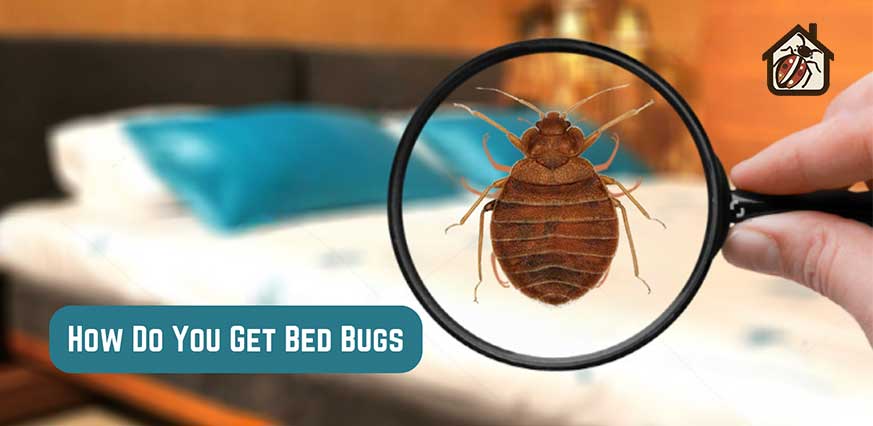
How Do You Get Bed Bugs
Welcome to the world of bed bugs – those small bugs that love to bite and make your nights annoying. They don’t bring diseases, but they sure can ruin your sleep and become a big problem in homes worldwide. Lately, more and more people are dealing with these little pests. In this blog, we’ll talk about how you get bed bugs and ways to tackle them for your comfy sleep.
Common places to get bed bugs
The sneaky travelers of the insect world – bed bugs, are master hitchhikers in moving around without anyone noticing. let’s talk about the usual suspects and the places where you might get bed bugs. They usually like cozy, warm spots, but honestly, they can pop up just about anywhere, making them a bit of a troublemaker for everyone.
Hotels and Motels
When lots of people come and go, like in hotels and motels, bed bugs love to join the party. They’re pros at hiding in things like mattresses, box springs, and even headboards. Watch out for used furniture, like sofas, in hotel common areas.
Public Transportation
Whether you’re on a bus, plane, or train, bed bugs might be cruising with you, especially on long trips. The close quarters and not-so-frequent cleanings make it easy for these pesky bugs to tag along.
Used Furniture
In secondhand furniture, you might get bed bugs it can be bed bug hangouts, especially beds, sofas, and chairs. Before bringing any used furniture home, give it a good look for signs of bed bugs, like little skins they shed, bloodstains, or the bugs themselves.
Apartment Buildings
Bed bugs are like tiny neighbors that can move between apartments through walls, outlets, and pipes. If one apartment gets bugs, it’s important to stay watchful and do things to stop them from moving into your place.
Laundromats
Believe it or not, laundromats can be a cozy spot to get bed bugs, especially if someone with bed bug clothes uses the same machines. Be careful when doing laundry in public places and maybe consider washing your stuff in hot water to zap any hidden bugs.
Movie Theaters and Public Seating
Even places like movie theaters or public seats in libraries can be hiding spots for bed bugs if they’re not kept super clean. So, be cautious and avoid putting your things right on the seats.
Retail Stores
Yep, even stores can have bed bugs, especially ones selling clothes or furniture. Be mindful of where you place your stuff while shopping, and try not to lay it directly on the floor or furniture.
Luggage and Bags
Bed bugs are like tiny stowaways that might hitch a ride on your luggage after you’ve been to a place with bugs. Always check your bags closely after traveling, and steer clear of putting them on surfaces that might have bed bugs.
How do bed bugs get into your home?
Let’s talk about bed bugs – those little bloodsuckers that somehow end up in your home. But how do they pull off this unwelcome feat? Well, understanding how these pests hitchhike is key to keeping them out of your space.
Travel
Traveling, whether for work or fun, is a common way bed bugs sneak into your home. They love hiding in hotel mattresses, furniture, and even your suitcase. Once you’re back home, they quickly make themselves at home in your place.
Tips for avoiding bed bugs from your travels:
- Check your hotel room for signs of bed bugs, like bugs themselves, shed skin or bloodstains.
- Use luggage racks, not the bed or floor, for your suitcase.
- Wash your clothes in hot water right after coming home.
- Give your luggage a good vacuum before storing it.
Second-Hand Furniture
Used furniture, especially beds, sofas, and chairs, is another favorite hiding spot for bed bugs. They tuck away in the corners and fabric, just waiting for a chance to move in.
Tips for avoiding bed bugs in used furniture:
- Check every nook and cranny of used furniture for signs of bed bugs before buying.
- Think about heat-treating the furniture before bringing it home.
- If you’re not sure about the furniture’s condition, it’s safer to skip buying it.
Other Ways Bed Bugs Hitch a Ride
While travel and second-hand furniture are the main culprits, bed bugs can also tag along through other routes, such as:
- Shared laundry places: They can hop onto clothes or bedding in shared laundry spots.
- Public transportation: Bugs may hide in the seats and corners of buses, trains, and planes.
- Visiting bug-infested homes: If you visit a place with bed bugs, you might unknowingly bring them home on your clothes or stuff.
Prevention for Bed Bugs
When Traveling
Smart Choices for a Bed Bug-Free Stay:
- Pick hotels with good reviews and a history of bug control.
- Inspect your room closely for bed bugs on the mattress, furniture, and baseboards.
- Keep your suitcase away from the bed and floor; use racks or a closed closet.
- Avoid leaving your clothes or things on the bed or furniture.
- Bring a flashlight and magnifying glass to check your room thoroughly.
- When back home, wash your clothes in hot water and vacuum your suitcase.
At Home
- Furniture Check to Keep Bugs Out: Before bringing used furniture home, you should inspect it closely for any signs of bed bugs. Consider heat-treating used furniture before bringing it inside.
- Seal Up the Hiding Spots: Close up any small spaces in your walls, baseboards, and around outlets where bed bugs might hide.
- Protect Your Bed: Use special covers for your mattress and box spring to keep bed bugs out.
- Regular Clean-Up Routine: Wash all bedding, including sheets and blankets, in hot water every week. You should vacuum your floors, carpets, and furniture regularly, especially around the edges and seams.
- Home Decluttering Tips: Get rid of extra stuff in your home, as bed bugs love to hide in clutter.
- Stay on the Lookout: Look for signs of bed bugs and check your home often to make sure they’re not there.
- Quick Action Plan: If you suspect bed bugs, don’t wait – call in the experts right away. They know how to handle these little troublemakers.
Home Prevention and Treatment
Let’s talk about bed bugs – those sneaky little insects that can show up in your home without you even realizing it. So, how do they pull off this tricky feat? Well, it all comes down to their knack for hitchhiking through different paths.
Travel
When you’re on the move, whether for work or fun, bed bugs often find their way to you. They love hanging out in hotels, motels, and even airplanes. These pests can easily hide in mattresses, furniture, and luggage, just waiting for the right moment to tag along with you back home.
How bed bugs can sneak in during travel:
- Hiding in luggage: They might crawl into your suitcase while you’re in a place with bed bugs.
- Crawling onto clothing: If you sit on furniture in an infested area, they can hitch a ride on your clothes.
- Traveling on public transportation: Bed bugs can lurk in the seats and corners of buses, trains, and planes.
Second-Hand Furniture
Another big source of bed bugs is second-hand furniture, especially beds, sofas, and chairs. These critters happily nestle into the nooks and crannies of used furniture, just waiting for a chance to make your home theirs.
How second-hand furniture can bring bed bugs into your home:
- Infested furniture: Furniture bought from a place with bed bugs might already have them.
- Hidden bugs: Bed bugs can sneak into the cracks and crevices of furniture, making them hard to spot before you bring them home.
What other ways do Bed Bugs Hitch a Ride?
While travel and second-hand furniture are the usual culprits, bed bugs can also find their way in through other means, like:
- Shared laundry facilities: They can crawl onto your clothes or bedding in shared laundry spots.
- Visiting infested homes: If you visit a place with bed bugs, you might accidentally bring them home on your clothes or stuff.
- Infested packages: In rare cases, bed bugs might hitch a ride on packages delivered to your home.
You may also like:
- How do I get rid of bed bugs
- Where do you sleep when you have bed bugs
- poor family who cannot get rid of bed bugs
Pay attention to the signs of bed bugs
Being watchful and spotting signs of bed bugs is crucial. Keep an eye out for:
- Live insects: Small, reddish-brown bugs about the size of an apple seed.
- Shed skin: Transparent, yellowish-brown skin bed bugs leave behind as they grow.
- Bloodstains: Rusty-colored marks on bedding or furniture from squashed bed bugs.
- Fecal stains: Dark brown or black spots that look like coffee grounds, left by bed bugs.
- Bites: Itchy red bumps, usually in a line or cluster, showing up on exposed skin during sleep.
What should you do?
If you think bed bugs might be crashing at your place, don’t wait around. Here’s what to do:
- Call in the pros: Get a professional pest control company to handle the situation.
- Hot water treatment: Wash all your bedding and clothes in hot water to get rid of any bed bugs or eggs.
- Frequent vacuuming: Pay extra attention to spots where bed bugs might hide, like mattresses, furniture, and baseboards.
- Regular home inspections: Keep an eye out for signs of bed bugs and take action to get rid of them ASAP.
FAQs
1. Where are bed bugs most commonly found in Canada?
2. How do bed bugs travel?
3. What are the signs of a bed bug infestation?
4. What should you do if you suspect a bed bug infestation?
5. Can you get bed bugs from used furniture?
6. Are bed bugs dangerous?
7. Who is responsible for bed bug treatment in Canada?
Conclusion
To sum it up, even though bed bugs are small, they can be a big bother. Understanding how they sneak into your home—whether it’s through travel, used furniture, or other ways helps you stop them. Just keep an eye out, check regularly, and act fast if you see any signs of these pests. By doing this, you can make sure your home stays bug-free, and you can sleep peacefully.


